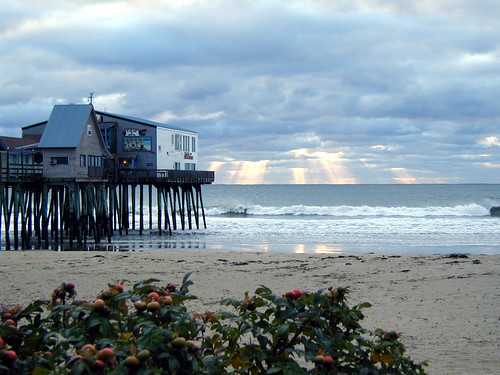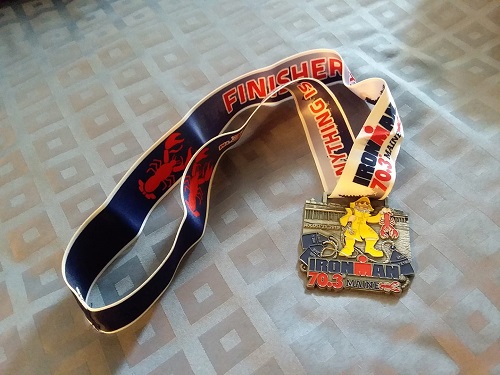Previously on The Undeniable Ruth: I had just exited Mirror Lake from the 2.4-mile swim and was walking the blue carpet to the transition area. As I entered transition area, I grabbed my bike gear bag and headed into the women’s changing tent.

Transition One (T1)
The race clock never stops running once you cross the threshold to start the swim until you either cross the finish line after the run or you DNF (Did Not Finish). While other athletes are motivated to move quickly, I take my time in transition. It’s my chance to rest and catch my breath. I ate a “calorie-bomb” cookie while I dried off and put on my cycling gear.
As I dried off my feet in the changing tent, I noticed the top of my left foot was bleeding – not badly, but I obviously cut myself during the swim. Maybe I kicked someone in the corner of their goggles or hit someone’s fingernail at just the right angle. I didn’t think much of it as I pulled on my yellow “Do Epic Shit” socks and cycling shoes and finished preparing for the 112-mile bike ride ahead.
As I looked around the tent, every person seemed to have a stick, can, or tube of anti-chafe product to apply to their crotch area to reduce discomfort during the ride. I sprayed Trislide down into the shorts of my trisuit (onesie for triathletes), sprayed any exposed skin with sunblock, tied my rainbow tie dye bandana to my head, and then put on my cycling gloves, helmet, and sunglasses. I slid my Chapstick and BASE salt into my back pocket and then walked out of the tent to grab my bike and headed to the bike exit.

Lap One: OMG Those Hills
Bike course was two 56-mile loops through Lake Placid Village and the surrounding areas. This course is notorious for its hills. Coach David tried to tell me what to expect, but nothing prepares you for how grueling those hills are. I knew that riding downhill out of town would feel great, and then the first of many climbs would begin.
I quickly learned to stay in the saddle instead of standing up on my pedals as I climbed each hill. It seemed counter-intuitive but keeping my butt on my seat allowed me to maintain a faster pace. It also caused more wear and tear on my crotch area.
Some of the descents on the course were exhilarating. Even while riding my brakes, I got up to 40 mph on one of them (according to my bike computer) while the more advanced cyclists were flying past me.
There were aid stations throughout the course, offering us bottles of water and Gatorade, gels, and bananas sliced in half. I don’t have the skill or balance to grab what I need as I ride through. Instead, I snapped my right foot out of its pedal and came to a full stop. I tossed my previous Gatorade bottle to the side and grabbed a fresh one, ate a half banana, and took a hit from my vial of BASE salt.
Conversely, Coach David can ride through the aid stations. We were both surprised when I finished the swim before him, but he made up time in T1, and passed me at the 1st aid station. Not that we were there to race each other. I didn’t care when I finished compared to the field as long as I finished in time to be an official Ironman.
Maybe I Need to Poop
It felt like there was no respite from the hills, and with each mile I felt more and more uncomfortable and miserable. Then the thought hit me: Maybe I need to poop.
At the next aid station (Mile 45), I gave myself a break from the race. I racked my bike and went to the porta-potty. Yes, it turned out, I needed to poop. (Actually, I pooped twice during that break.) I walked around a bit and dumped a bottle of cold water over my head.
My break allowed me to take in more of my surroundings. I realized each aid station had a kiddie pool of ice so the volunteers could chill our bottles of water and Gatorade before handing them to us. That was such a thoughtful touch.
Feeling a bit refreshed, but still tired, I was ready to continue on. I wondered if I was feeling miserable because I wasn’t refueling properly. I ate a gel (electrolytes + caffeine) and made a concerted effort to drink more of my protein. It felt thick in my water bottle. To thin it out, I’d take in a sip of my water, spit it into my protein bottle, shake, and drink. I began to feel better once these additional calories hit my system.
At each subsequent aid station, I also dumped a bottle of cold water over my head to make sure I wasn’t inadvertently overheating.

Lap Two: Accept the Pain
As I headed into the second lap, I thought about “acceptance.” I learned a valuable lesson about acceptance years ago at the piercing parlor.
It was an impulse piercing, and none of my friends were available to hold my hand. I death gripped the piercing table with anxiety as my piercer prepared his materials. He looked down at my white knuckles and said, “This isn’t going to work.” He told me to let go of the table, breathe, and accept the pain as part of the process. That day I learned how to take a piercing without flinching.
Even though the second lap was more difficult that the first one now that my muscles were getting sore, it was less painful than the first one as regularly reminded myself, “accept the pain.” I even started smiling and somewhere during this lap, I started playing Frank Sinatra singing “My Way” in my head. It didn’t matter if other athletes were faster; I was there to do my race.
As my legs became more fatigued, my body automatically tried to compensate by death gripping my handlebars, as if I could pull myself up those hills with my hands. I had to periodically shake out my hands and force myself to drop my shoulders and relax my trapezius.
“So Proud”
Toward the end of the 112-mile ride, I was ready to be done with this portion of the race. At first, my only thought was, “Are we done yet?” but then I started thinking about a text message I received from my friend Julia the day before: “So excited for you. So proud.” Hearing her voice in my head motivated me to push through those last few miles.
I was so relieved to see the familiar sites of Lake Plaid Village as I approached the end of the bike segment. After nearly 8 hours of riding (7:56), I was ready to get off my bike.
Next week’s post: Ironman Lake Placid – The Run.







